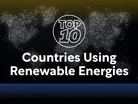Top 10: Countries Using Renewable Energies

From China to Brazil and Norway to India, these ten countries set the standard for renewable energy generation, driving the global shift towards a sustainable future.
As the world pivots towards greener energy sources, countries, corporations and individuals re-evaluate their energy consumption to align with sustainable practices and environmental goals.
2023 global wind capacity reached 1,017 GW, with China and the US at the forefront. Bioenergy also grew by 3%, with significant advances in Japan, Brazil and Uruguay.
By 2025, renewable sources expect to supply 35% of the world's electricity, surpassing coal for the first time.
According to the International Renewable Energy Agency (IRENA), these ten countries are the leaders in renewable energy production, utilizing solar, wind, hydropower, geothermal and biomass to make remarkable strides.
10 | Spain
- Renewable Power Generation: 130 TWh
Spain has rapidly increased its renewable capacity, with wind and solar leading. As of 2023, over half of Spain's electricity comes from renewable sources, with wind contributing 24% and solar PV 14%.
Spain's energy giant, Iberdrola, has been pivotal in expanding the nation's renewable capacity, focusing on electrification and energy storage.
9 | Norway
- Renewable Power Generation: 140 TWh
Norway boasts the highest share of electricity from renewable sources in Europe, primarily due to its abundant hydropower resources, which account for 92% of its electricity generation.
As one of the world's largest energy exporters, Norway is a leader in developing new technologies like EVs, carbon capture and storage (CCS) and hydrogen, driven by its natural advantages.
8 | Russia
- Renewable Power Generation: 198 TWh
While fossil fuels dominate Russia's energy mix, renewable energy still plays a substantial role, particularly hydropower, which provides 17% of the country's electricity.
In recent years, Russia has seen growth in other renewable sectors, although its overall progress remains modest compared to that of global leaders.
7 | Japan
- Renewable Power Generation: 239 TWh
Japan is actively expanding its renewable energy share to reduce CO₂ emissions and reliance on imported fossil fuels.
Mitsubishi Electric is spearheading the development of energy-efficient technologies and renewable energy integration, supporting Japan's goals for greater energy efficiency and reduced carbon emissions.
6 | Germany
- Renewable Power Generation: 254 TWh
Germany has been at the forefront of renewable energy adoption, with over half of its electricity coming from renewables in 2023.
The country is a critical player in the EU's efforts toward carbon neutrality by 2050, with wind, biomass and solar leading its green energy mix.
5 | Canada
- Renewable Power Generation: 388 TWh
Canada is a global hydroelectric powerhouse, accounting for 66% of its total electricity generation.
The country is expanding its wind and solar capacities to transition to a low-carbon economy, with organizations like Brookfield Renewable Partners driving the shift towards sustainable energy solutions.
4 | India
- Renewable Power Generation: 405 TWh
India is both a major electricity consumer and the third-largest renewable energy producer globally.
The country is on track to double its renewable capacity by 2026, with significant investments in green hydrogen and renewables helping it achieve its Paris Agreement targets nine years ahead of schedule.
3 | Brazil
- Renewable Power Generation: 940 TWh
Brazil leads the world in clean electricity production, with 93% of its power generated from renewable sources, including hydropower, solar PV and wind.
The country is investing heavily in green fuels, energy storage and hydrogen, positioning itself as a global leader in sustainability.
2 | USA
- Renewable Power Generation: 1,493 TWh
The US is seeing rapid growth in renewable energy, with wind and solar playing significant roles.
In 2023, renewables accounted for over 21% of the nation's electricity and this trend is expected to continue as costs decrease and environmental policies strengthen.
1 | China
- Renewable Power Generation: 3,749 TWh
China is the world's largest producer of renewable energy, generating 35% of its electricity from clean sources in 2023.
While coal still plays a significant role, China's massive solar, wind and hydropower investments demonstrate its commitment to balancing economic growth with environmental sustainability.
Receive the next edition of Scope 3 Magazine by signing up for its newsletter.
As part of this portfolio, make sure you check out Procurement Magazine and also sign up to our global conference series - Procurement & Supply Chain LIVE.
Also check out our Sister Brand, Sustainability Magazine and sign up to its global conference series - Sustainability LIVE.
Scope 3 Magazine is a BizClik brand.

